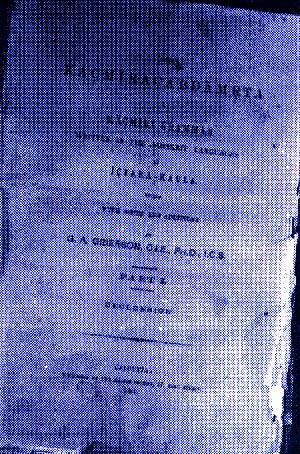Pandit Ishwar
Kaul
"Panini of
Kashmir"

| [
Pandit
Ishwar Kaul assured for himself an
esteemed place in the galaxy of Kashmiri
scholars by giving Kashmiri its first
grammar - the 'Kashmir Shabdamrita'.
Written in Sanskrit after the manner of
the great Sanskrit grammarian Panini,
Ishwar Kaul's treatise on Kashmiri
grammatical forms bears testimony to his
profound study of the language. He also
pioneered lexico- graphical work on
Kashmiri, though death prevented him from
completing his 'Kashmiri and Sanskrit
Kosha'. While presenting here a profile of
the great scholar, we regret we have not
been able to procure his photograph
despite our best efforts. We have,
however, tried to compensate for it by
publishing a photograph of the front cover
of his monumental work the 'Kashmir
Shabdamrita.' ] |
The
19th century saw the Kashmiri Pandit community
throw up giants in the field of learning and
letters. Contacts with the West set into motion
processes that led to an intellectual ferment in
Kashmir, inspiring the Pandits to rediscover and
reinterpret their past and undertake new and
challenging scholastic ventures mostly in
collaboration with Western scholars, but also
independently. Among the titans of the age who
chartered an independent course ror themselves was
Pandit Ishwar Kaul (IK) of Srinagar.
Born on 4th July, 1833 in
a family deeply steeped in Sanskrit lore, IK lost
his father, Pandit Ganesh Kaul, when he was just
three years old. He first studied under Pandit
Tikkaram Razdan, who was one of the most renowned
Sanskrit Pandits of that time. Later IK learned
from Pandit Daya Krishna Jyotishi of Benares who
had come to Jammu in the service ol Maharaja
Ranbir Singh of Jammu and Kashmir. Equally
proficient in Sanskrit and Persian, IK was also
fairly conversant with Arabic. These credentials
were enough for the Maharaja to offer him the
assignment in 1861 of translating Persian and
Arabic works in his library into Sanskrit and 'Bhasha'
(Hindi). Ten years later, in 1871, IK was
appointed the Head Teacher at the Sanskrit
Pathshala opened by Maharaja Ranbir Singh in
Srinagar.
Kashmiri Pandits are
known to have have a penchant for producing works
of grammar, as is proved by the several
grammatical treatise they authored on Sanskrit.
The earliest grammar of Tibetan was composed by a
Kashmiri Pandit, and so was the first Gujrati
grammar. IK continued the tradition by writing the
first grammar of the Kashmiri language, a
brilliant work about which George Grierson wrote:
"It is an excellent work and might have been
composed by the Hemachandra himself." Modeled
on the great Panini's 'Ashtadhyayi' and written in
Sanskrit, IK's 'Kashmir Shabdamrita' reveals his
perfect knowledge of the linguistic structure of
Kashmiri. Edited by Grierson with "additions
and notes", the work was published by the
Asiatic Society in 1897. IK, however, is said to
have composed it in 1875, or, perhaps in 1874, as
his son Anand Kaul believed, and revised and
improved in 1879.
IK was also a pioneer
lexicographer in Kashmiri, even though his
Kashmiri- Sanskrit Kosha remained half-complete
due to his death. Grierson compiled his four
volume dictionary of the Kashmiri language from
the materials from IK's fragmentary Kosha,
compiling it with the assistance of Pandit
Mukundram Shastri and Prof. Nityanand Shastri and
publishing it in 1932. Ishwar Kaul "never
lived to complete, much less revise, his Kosha",
writes Grierson in the preface to his dictionary.
It goes to the credit of
IK that he was the first to use the Devanagri
script for transcribing Kashmiri words both in his
grammar and his dictionary. He expressed typical
Kashmiri vowel sounds by using diacritic marks,
mainly the horizontal bar and the 'halanta'.
Grierson, and later Master Zinda Kaul and Prof. S.
K. Toshkhani used the Devanagari characters for
Kashmiri with a more elaborate system of
diacritical notation.
In the year 1881, IK was
made Director of Translation Department of the
Jammu and Kashmir state. The department, set by
Ranbir Singh, was wound up in 1884 after the
Maharaja died. His successor, Maharaja Pratap
Singh appointed IK as Head Jyotishi or Chief
Astrologer at his court, a post that he held until
his death on 28th August, 1893.
IK's genius was best
summed up by Sir Aurel Stein when he described him
as the "Panini of Kashmir".
Source:
Unmesh
- Monthly Newsletter of N.S.
Kashmir Research Institute
|
